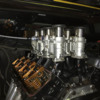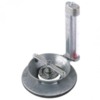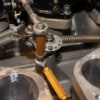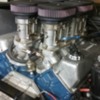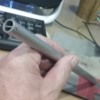quote:
Originally posted by René #4406:
To synchronize depressions the procedure is as follows:
- close ALL air-screws completely and adjust the linkage so that all carburetors are just completely closed.
- screw the general idle-screw so that the engine can just idle
- Carburetor per carburetor, open the air-screw of the barrel which has the greatest depression until the two depressions are the same.
- Adjust the linkage between the two carburetors of each bank of cylinders to obtain the same depression on the four barrels. It may be necessary to retouch the air-screws but always acting on the same screw
- adjust the linkage between the two banks of cylinders. Again it may be necessary to retouch the linkage between the two carburetors of a bank and possibly air-screws
- after each adjustment, give a short throttle and let the engine come back to idle then adjust the speed of the engine with the idle-screw
At the end, each of the four carburetors must have one of its two air-screws fully closed.
Then adjust the richness of each barrel with the gas-screw to obtain the highest engine speed but on an 8 cylinders, it is necessary to have a very fine ear or a lot of experiment, from where the utility of lambda probes.
I do not know in the US but in France there are almost no mechanics who still able to do that, the good repairers of motorcycles, when they agree to work on a car, know how to do.
It is already long to properly synchronize a four-cylinders, I do not imagine what it is for an 8. Good courage.
On 48IDA's it is unusual to be able to get all 8 cylinders to idle equally.
You can't even get the same carbs equal. Once cylinder usually will be higher then the other.
You need to experiment to see if the dominant cylinder on each carb is the higher or the lower setting,
For me it normally works out to be no more then one gradation mark on the sync tool.
Then it is balancing back and forth until you have them close.
The plugs should be a dark brown. Some describe that as a rust color. They should not be black.
On my engine, the idle set screw vary slightly from cylinder to cylinder but are in the 5/8 to 3/4 turn out.
It's very common to foul a set of plugs up while doing this. In fact, maybe two.
I have found that with the ida's, the ignition likes a slightly hotter plug but also remember that I am using different cylinder heads. Aluminum, not iron.
They have different requirements.
Also, in case you have not already discovered it, the engine likes an idle jetting of .60f/.85a.
Depending on the camshaft configuration, you may also be able to lean that out to a .90 idle holder.
For a long time, the only idle jetting available was a .70f/1.20air (idle jet holder). The seemingly sudden availability of small air jet holders made leaning down the idle possible along with adding a third transfer hole to reduce the transfer flat spot.
Forget about trying to get a lean idle with the carbs. About 12.5-12.0:1 at idle is as lean as you can go without the carbs popping through the exhausts at idle.
You HAVE to install the linkage before you do any of this and you are going to need to work back and forth from the idle screws to the linkage to zero it.
This isn't easy AND if your linkage does not have the right geometry, once you drive the car, the idle will be all wrong again.
The set up of Nate's car is using Inglese's re-orientation plates. That was Jim's solution to removing the over/under linkage working off of the center turnbuckle and tower.
It worked on my '68GT350, but not on my Pantera. My Pantera I could only make work with the center tower.
The ONLY reason that you use those reversing plates is to simplify the linkage.
When you reverse the one bank of carbs to put them all in parallel throttle positions, you loose power in the engine because you loose line of sight from the throttle to the intake valve.
How much I can't say scientifically because I never dynoed all of these possible combinations but I can feel the difference as a driver.
I would SUSPECT something like 25hp loss or the difference of running a Holley carb with a factory air cleaner or an open carb.
Mine idle now at 775rpm, with 15 degrees initial advance and a non Weber camshaft with 245 degrees duration @ .050 and 72 degrees of overlap.
You will also see the idle vacuum change as you make these changes and adjustments. I can only get about 11.5-12 inches at this idle speed. More if I idle up. Probably 14 at about 1,000 rpm?
I don't worry about that any more since I put a vacuum pump in the car and that gives like 18-20 inches for the vacuum accessories.
So it is possible to get them "civil" (depending on your definition), it just takes a lot of patience and as I remember about 2 weeks of work to get it right.
I remember Inglese making the final comment to me on the Shelby, "if you think they are right now (or you are happy with them) LEAVE THEM ALONE!"
I don't see how you can save all of the settings when you take them off of the car. You are going to have to go through this every time you reinstall them. Settings are so sensitive that just one bump in disassembly changes things.
Others I am sure have different experiences? These are just some of mine and solely intended to save you some of the pain. However, if you are into pain and love the challenge, challenge away! Have fun.
Oh...I have found that the P-E iginition is a gift from "Heaven" with the Webers. If will fire and clean up a completely fouled plug. NO other system will do that. Not the Ford or the MSD.
In fact, it was the MSD that kept failing and wouldn't start the car after sessions of "Weber tuning". That just compounded the issues and made it near impossible to determine where the problem was.


